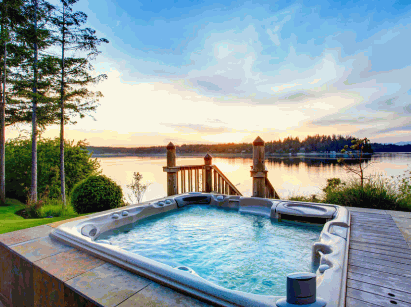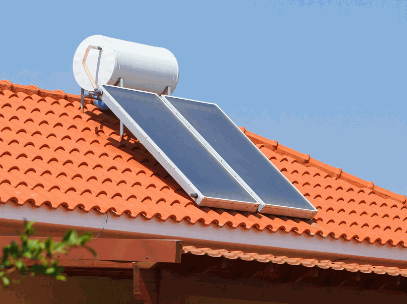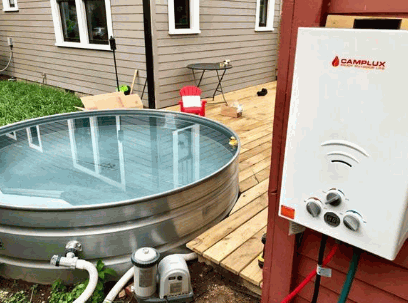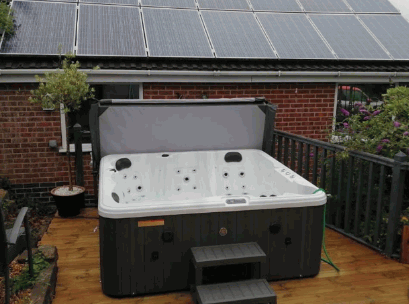A hot tub is a great place to chill out, ease those aching muscles, and enjoy time with loved ones. It's a bit of a luxury item, and it may have taken years of hard work and sacrifice for some hot tub owners to achieve this, but it's becoming increasingly difficult to justify the expense due to the sharp rise in energy costs.
On top of this, we are being urged to reduce energy consumption in order to reduce our environmental impact because of concerns about climate change.
That's why so many consumers are turning to environmentally friendly alternatives like solar power, as it offers the best of both worlds: it doesn't use fossil fuels, and once you've made the initial investment, you basically get free energy from the sun!
Skylamp Solar is honoured to be a part of the transition to sustainable energy sources like solar power, and we often get asked whether solar panels can power a hot tub. While we covered this topic in another blog (called Can You Run A Hot Tub On Solar Power?), there are many other questions to consider, such as, how many solar panels does it take to run a hot tub?
That's what we aim to answer in this article so you can get a better idea of the size of the solar array you'll need and decide whether it's a viable option for you.

As technology has developed, we've seen dozens of new and improved solar panels with better efficiency and sleek, modern designs. Essentially, however, they are broadly split into two (or maybe three) types: solar thermal panels and photovoltaic (PV) panels.
It's important to know the difference before buying, although a professional solar power company (like Skylamp Solar) will always make sure that you are fully aware of all the facts.
To help you out, here's a quick guide to the differences:
Also known as solar water heaters, these are designed to capture heat from the sun's radiation and convert it into usable thermal energy. They consist of a series of flat or curved collectors mounted on a frame and positioned to maximise sunlight exposure. The collectors are typically made of a material like copper or aluminium, which efficiently absorbs the sun's heat.

A heat-transfer fluid, such as water or an antifreeze solution, circulates through the collectors, absorbing the captured heat. This heated fluid then transfers its energy to a storage tank via a heat exchanger, where it is stored until required for domestic hot water or space heating applications.
Solar PV panels, also known as solar electric panels, convert sunlight directly into usable electricity. This electricity can be used to power household appliances, charge electric vehicles, or even feed into the national grid.
Dig Deeper: What Is Solar PV
PV panels are composed of multiple photovoltaic cells, which are essentially miniature solar power generators. Each cell contains a semiconductor material, such as silicon, that exhibits the photovoltaic effect.
When sunlight strikes a PV cell, it excites the electrons within the semiconductor material, causing them to flow and create an electric current. This current is then directed to an inverter, which converts it from direct current (DC) to alternating current (AC), the form of electricity used in homes and businesses.

The primary difference between solar thermal and PV panels lies in their energy output:
Another difference - and an important one - is that solar thermal is generally more efficient than solar PV. On average, solar thermal is around 70% efficient, whereas solar PV is more like 25% (although this is being improved all the time).
Earlier, we hinted that there was a third type, and this is the hybrid system that combines the two methods.
With all of this in mind, let's move on to try and answer our main question to see how many panels you might need.
Learn more: What's The Difference Between Solar Panels And Photovoltaic Panels
As well as the type of solar panel system used, the number of solar panels required depends on several other factors, including the size of the tub, how much energy it needs, and the average amount of sunlight in your area.
The size of your hot tub, measured by the water capacity, is a crucial factor in calculating the required number of solar panels. A larger hot tub with a higher water volume will demand more heat energy to maintain the desired temperature. Similarly, the frequency of hot tub usage also influences the overall energy consumption.

How much electricity does it use? The average hot tub comes in at around 5.5kWh while in use. Also, it needs to be kept switched on when not in use, as it takes a tremendous amount of energy to heat cold water every time.
We also need to keep an eye on the amps it draws, as hot tubs vary between 20 and 80 amps, depending on its capacity.
The amount of sunlight received at your location directly impacts the performance of solar panels. Consider the average sunshine hours in your area and the orientation of the panels when fitted; south-facing panels will draw more of the sun's energy than those facing in other directions.
A solar inverter is a crucial component of PV systems, converting the direct current (DC) output from the panels into alternating current (AC) suitable for household appliances. The size of the inverter needs to match the total power generation capacity of the solar panels.
Delve into: What Size Inverter Do I Need For Solar Panels
This is crucial to the success of a photovoltaic solar system, as you need to ensure that you have adequate storage so you can harvest the sun's energy generated when the hot tub is not in use.
In terms of solar PV, this is the amount of electricity generated by each PV panel. Panels typically come in sizes ranging from 300 watts to 400 watts.
Taking into account all of the above factors, here's an approximate guide to the number of solar panels you might need:
Remember, this is only a guide, and it's best to consult an expert like Skylamp Solar.
Uncover more: How Many Solar Panels Do I Need

Each type has its benefits and drawbacks, although solar heating systems (the thermal type) are much more efficient.
While solar PV is quicker, you need to invest in a battery system to harvest the sun's energy when the hot tub isn't being used. This can be used later in the evening when the sun has gone down.
To increase the efficiency of PV, you could combine it with a heat pump, and this method is proving to be very popular with consumers.
While thermal panels are far more efficient, it takes about six hours of strong sunlight to heat up the water. You'll also need a powerful enough pump to get the water to and from the heat exchanger to the hot tub, and it is difficult to store the hot water when not in use.
In the end, you need to make a decision based on your own preferences and budget, but we are always here to offer advice.
Figuring all of this out can be a chore, although the experts at Skylamp Solar are happy to guide you.
Alternatively, you can now buy a solar-powered hot tub kit. These self-contained units come ready assembled and are sold in different sizes to suit your hot tub setup. They are relatively easy to install and are proving to be a real hit with customers across the UK.
Rather than the flat or curved panels we're used to seeing, most of these look like small pyramids, and the units can be disguised with attractive wooden covers. This new innovation is likely just the beginning of a transformation in the solar heating system industry!

A solar-power hot tub can help you save money on your energy bills and reduce your carbon footprint, and that's a fact.
However, there are some conditions attached!
First, you need to choose the right solar power system, and then you need to consider investing in heat pumps and a battery system (if you opt for solar PV). It's vital to make sure that solar systems deliver enough power to run a hot tub all year round, even in the winter months.
That means calculating carefully how much usable power your hot tub requires unless you choose a ready-made solar-powered hot tub kit. Even so, both require proper installation to get the best out of it and provide significant savings.
We've given you some insight into solar power and looked at how many solar panels hot tubs require, but it's not a simple subject by any means, so feel free to contact us for clarification.
However, it's safe to say that solar power is the way to go; renewable energy is great for saving money and the planet! Clean energy is cheaper than traditional methods, offering a cost-effective way of reducing electricity costs and lessening your environmental impact.
If you want to enjoy your hot tub without worrying about your electricity bills while becoming more environmentally friendly, why not give Skylamp Solar a call?
